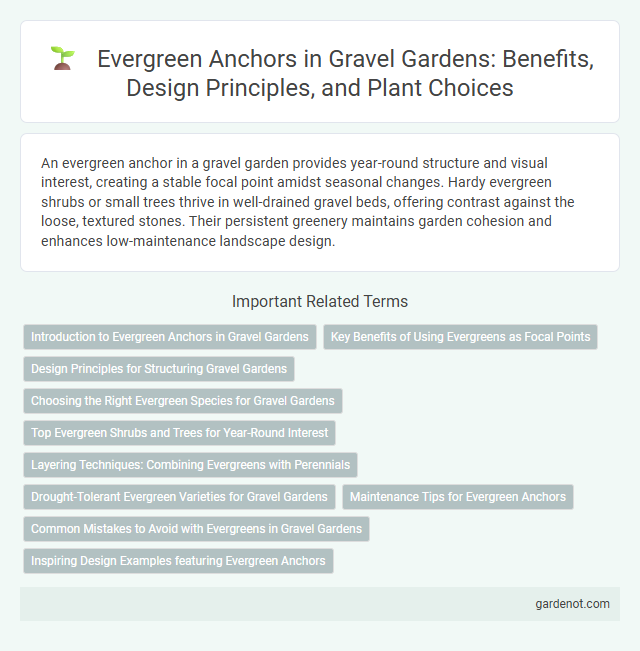An evergreen anchor in a gravel garden provides year-round structure and visual interest, creating a stable focal point amidst seasonal changes. Hardy evergreen shrubs or small trees thrive in well-drained gravel beds, offering contrast against the loose, textured stones. Their persistent greenery maintains garden cohesion and enhances low-maintenance landscape design.
Introduction to Evergreen Anchors in Gravel Gardens
Evergreen anchors in gravel gardens serve as year-round focal points, providing consistent structure and color amidst the shifting textures of gravel and seasonal plants. Species such as boxwood (Buxus sempervirens) and dwarf conifers maintain their foliage throughout all seasons, ensuring visual interest and stability in garden design. Their low-maintenance nature and adaptability to well-drained, gritty soils make evergreen anchors essential for sustainable and aesthetically pleasing gravel garden landscapes.
Key Benefits of Using Evergreens as Focal Points
Evergreen anchors provide year-round structure and visual interest in gravel gardens, maintaining vibrant color and form through all seasons. Their low maintenance and drought tolerance make them ideal for sustainable landscaping, reducing water usage and upkeep efforts. These plants also enhance habitat value by offering shelter and food for wildlife throughout the year.
Design Principles for Structuring Gravel Gardens
Evergreen anchors in gravel garden design provide year-round structure and visual stability, essential for maintaining interest across seasons. Key design principles include selecting drought-tolerant evergreens with varied textures and heights to create focal points that contrast with gravel's neutral tones. Proper placement ensures balanced composition and supports natural drainage, enhancing both aesthetics and garden sustainability.
Choosing the Right Evergreen Species for Gravel Gardens
Selecting the right evergreen species for gravel gardens involves prioritizing low-maintenance, drought-tolerant plants such as boxwood (Buxus sempervirens), juniper (Juniperus spp.), and dwarf conifers. These species provide year-round structure and color while thriving in well-drained, nutrient-poor soils typical of gravel gardens. Choosing evergreens with varied textures and shades enhances visual interest and supports a balanced, sustainable landscape.
Top Evergreen Shrubs and Trees for Year-Round Interest
Top evergreen shrubs and trees suitable for gravel gardens include boxwood (Buxus sempervirens), holly (Ilex aquifolium), and yew (Taxus baccata), all providing dense, year-round foliage. These evergreens offer structural form and vibrant greenery that complement gravel textures while minimizing maintenance. Incorporating varieties such as dwarf conifers or dwarf laurels enhances seasonal interest without overwhelming limited space.
Layering Techniques: Combining Evergreens with Perennials
Layering techniques in gravel gardens create dynamic visual interest by combining evergreen anchors with seasonal perennials, ensuring year-round structure and vibrant color changes. Using evergreens like boxwood or juniper as foundational elements provides consistent greenery and texture, while complementary perennials such as lavender, sedum, or salvia add seasonal blooms and seasonal variation. This strategic layering promotes biodiversity, enhances soil stability, and reduces maintenance in drought-prone gravel landscapes.
Drought-Tolerant Evergreen Varieties for Gravel Gardens
Drought-tolerant evergreen varieties such as Juniperus communis, Lavandula angustifolia, and Rosmarinus officinalis provide essential year-round structure and color to gravel gardens. These hardy evergreens thrive in well-drained, nutrient-poor soils typical of gravel gardens, reducing water requirements and maintenance. Incorporating these species enhances the garden's resilience while maintaining visual interest throughout all seasons.
Maintenance Tips for Evergreen Anchors
Evergreen anchors require consistent pruning to maintain their dense foliage and promote healthy growth throughout the year. Regular watering during dry spells and mulching around the base can help retain soil moisture and reduce weed competition. Monitoring for pests such as aphids and treating infestations promptly ensures the longevity and vibrant appearance of these key gravel garden plants.
Common Mistakes to Avoid with Evergreens in Gravel Gardens
Overwatering is a frequent error when planting evergreen anchors in gravel gardens, leading to root rot due to poor drainage. Choosing species that are not drought-tolerant often causes stress and poor growth in gravel environments. Neglecting proper soil preparation and failing to mulch can reduce moisture retention and increase weed competition around evergreens.
Inspiring Design Examples featuring Evergreen Anchors
Evergreen anchors create year-round structure and visual interest in gravel gardens, enhancing both texture and color consistency. Combining boxwood, holly, or euonymus provides durable, low-maintenance focal points that frame pathways and define garden beds. These resilient plants thrive in well-drained gravel settings, supporting sustainable garden designs with strong architectural presence.
Evergreen anchor Infographic

 gardenot.com
gardenot.com